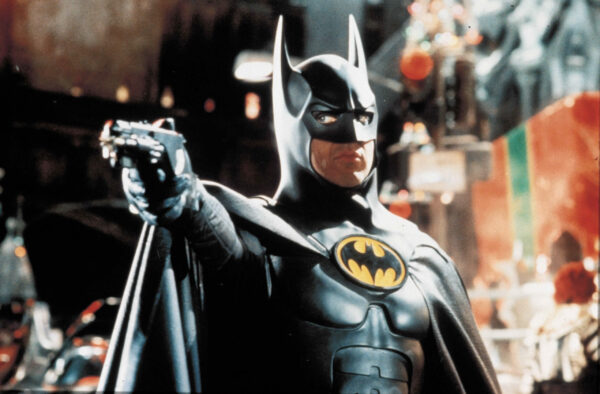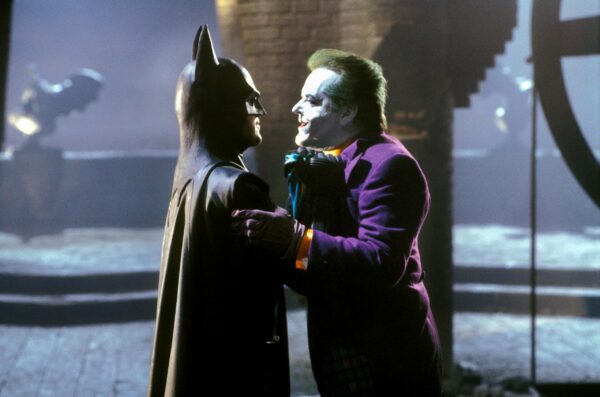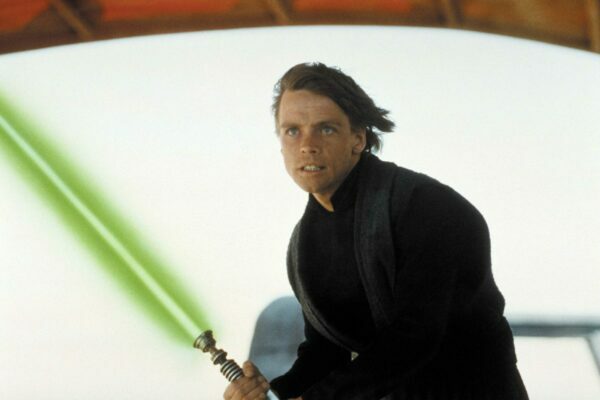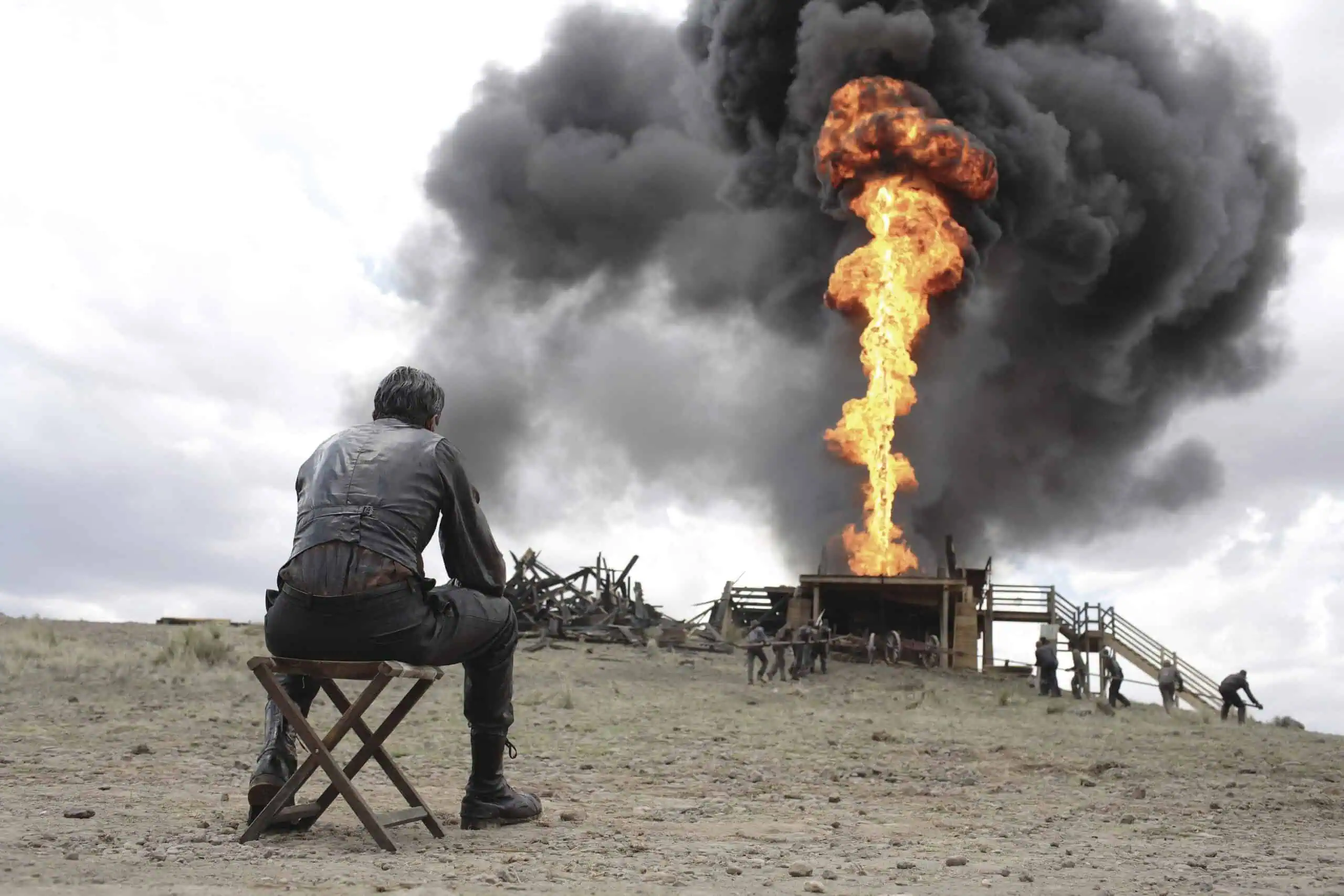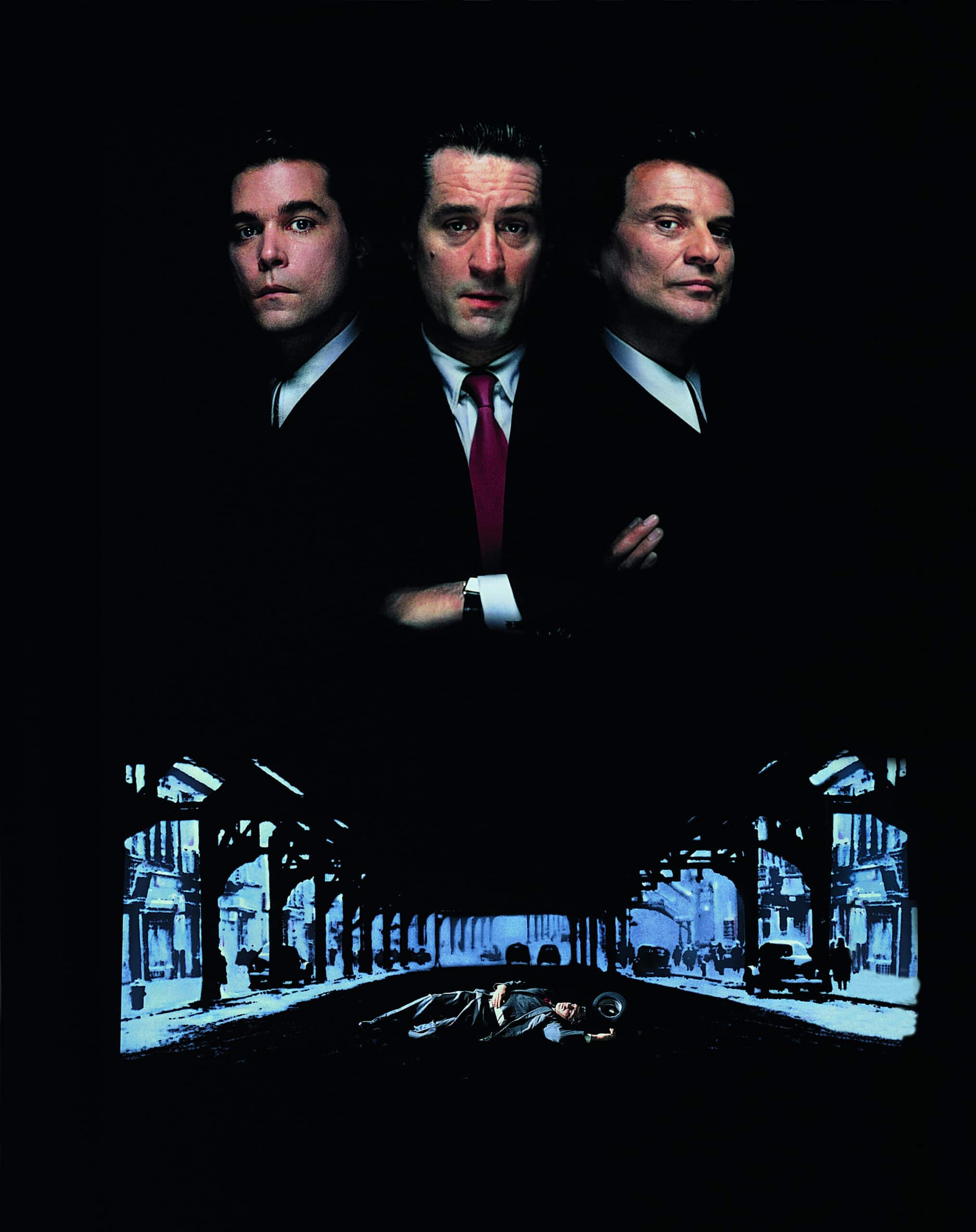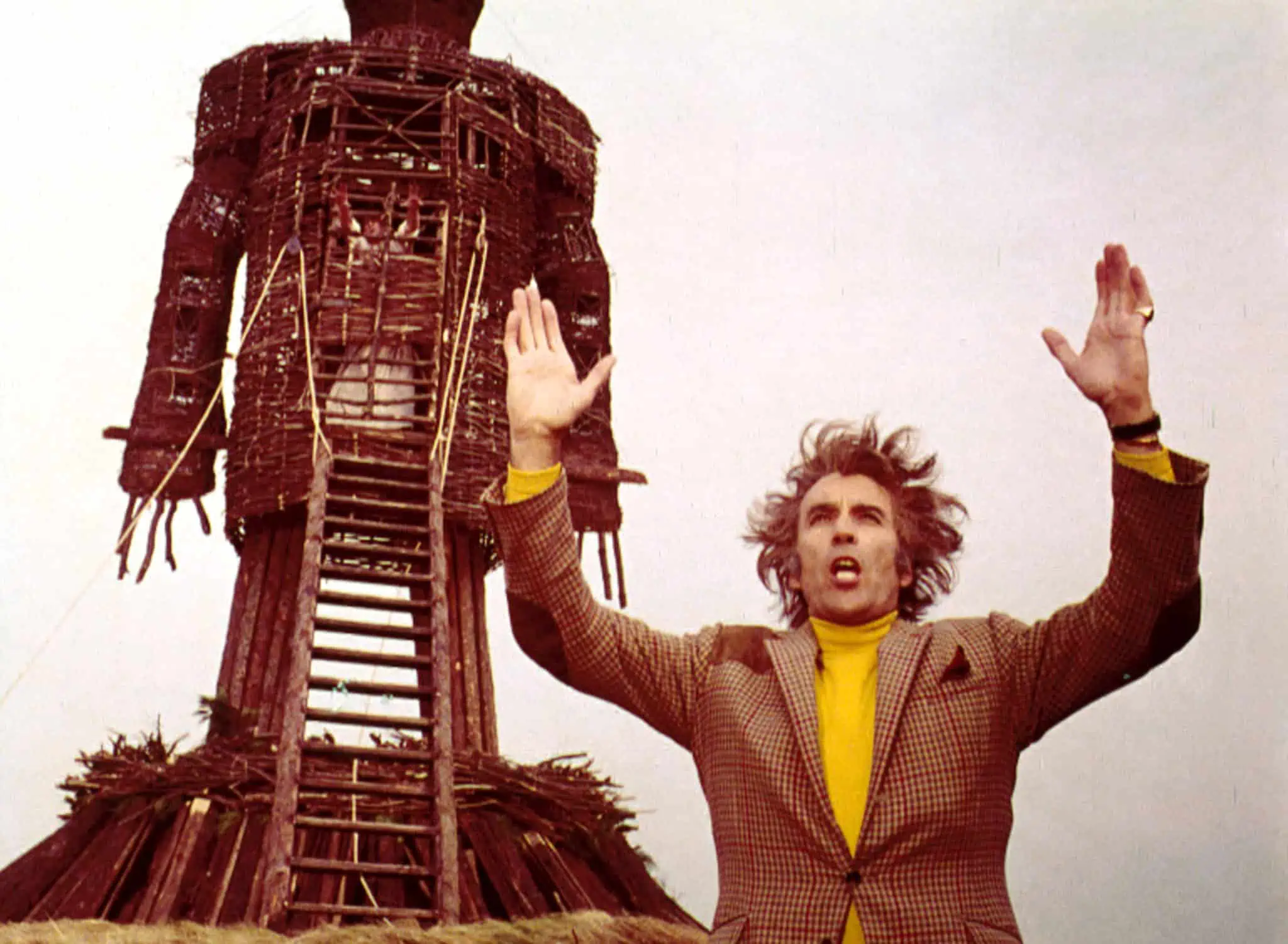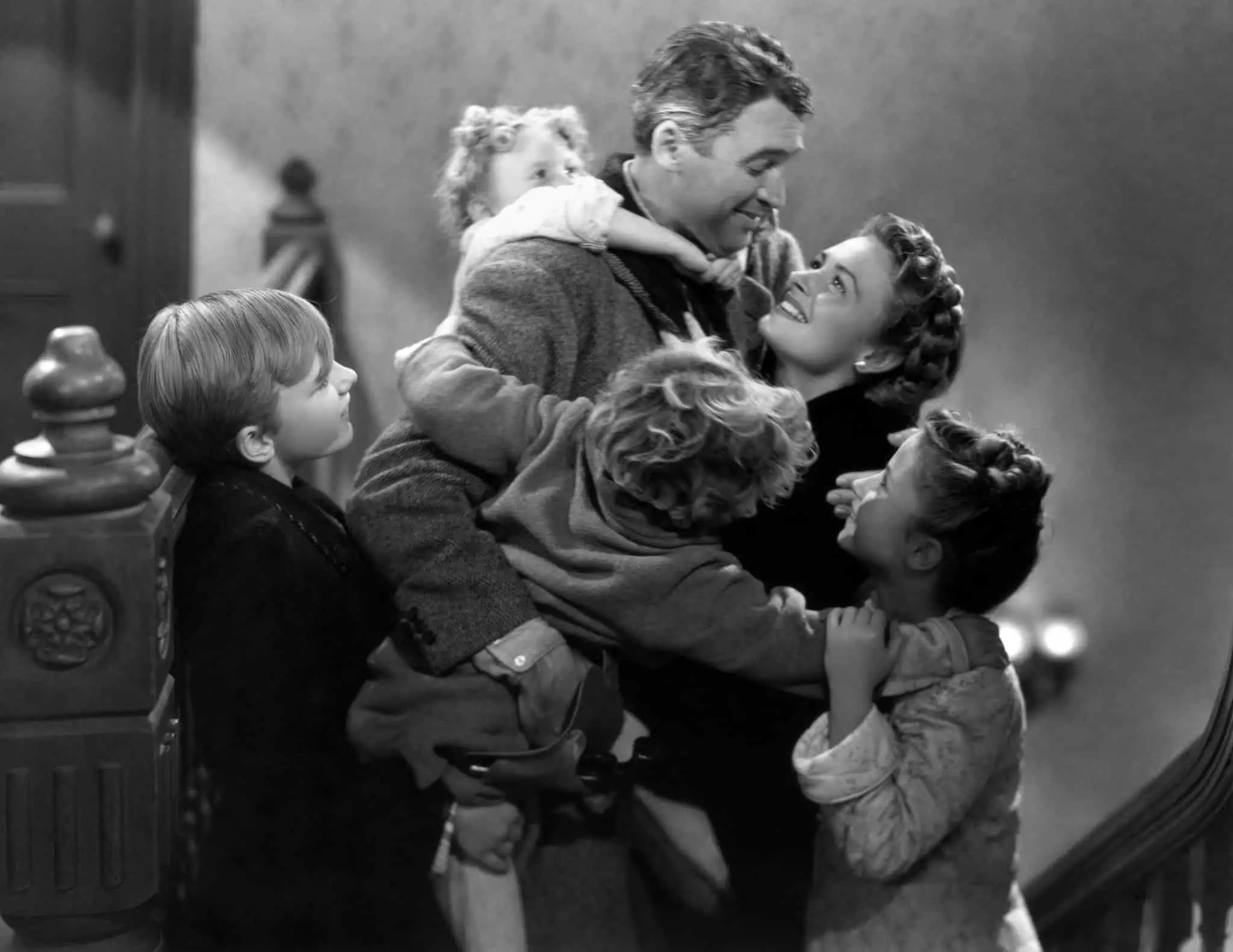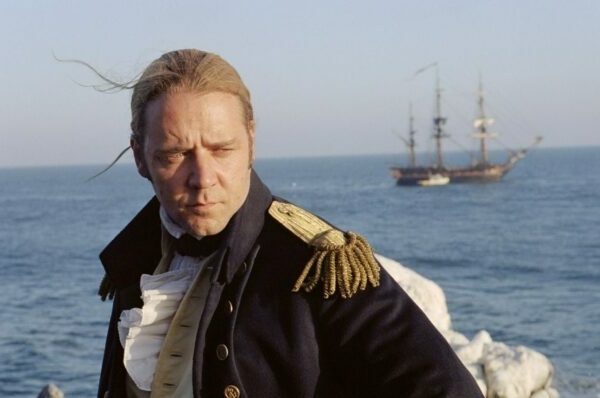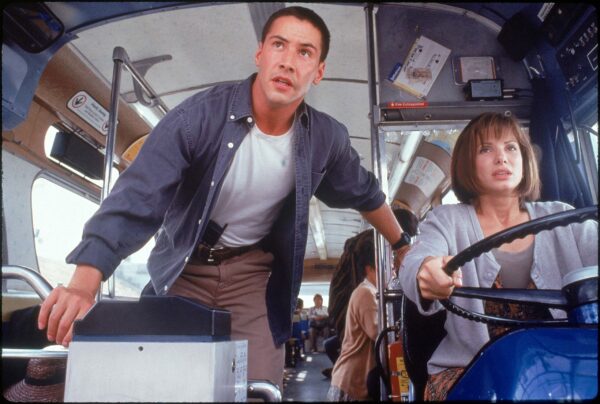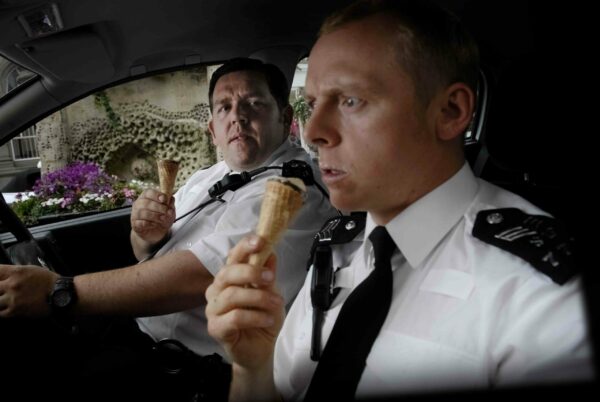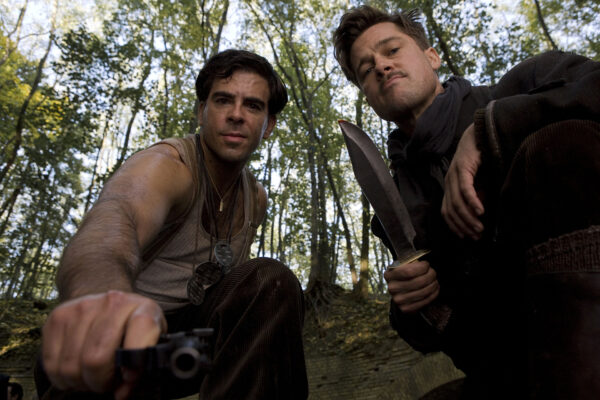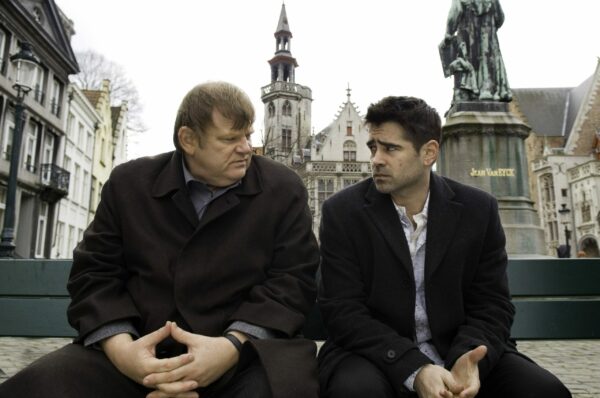
Frank Capra’s It’s A Wonderful Life is the Holiday movie to end all Holiday movies. Telling the story of George Bailey and his run in with his guardian angel, Clarence, one dark Christmas Eve, it has grown in stature since its 1946 release to be revered as a true Christmas classic and, for many, the greatest festive film ever made.
By way of 30 fascinating facts, we bring you the making of story behind Capra’s Christmas cracker.
1. The opening to the film was originally very different
The film opens with a young George Bailey, playing with friends. They’re sledging on a frozen lake and, when George’s brother, Harry, breaks the ice and goes under, George leaps into action to save him. In the first draft of the script, though, this sequence was quite different.
Originally, the boys weren’t sledging, they were playing ice hockey on a lake which was part of villain-of-the-piece Henry Potter’s property. George hit the puck into Potter’s yard, which infuriated Potter and he released the dogs. The boys made a run for it and that’s how Harry fell in the ice, where George saved him.
2. The scene where Mr. Gower strikes young George wasn’t entirely make believe
One of the most famous parts of the movie is when, after young George stops his boss, pharmacist Mr. Gower, from poisoning his customers, Gower slaps George for not delivering the prescriptions, making the young boy’s ear bleed.
Young George was played by a child actor called Robert J. Anderson and, years later, he said that H.B. Warner, who played Mr. Gower, was a method actor and actually got drunk when filming this sequence. So the slaps, and the hugs after it, were all real.
Mr. Gower makes young George’s ear bleed
3. Another well known scene was originally a lot different
When he realises Mr. Gower has unwittingly put poison inot the prescriptions, young George goes to his father’s Building and Loan company seeking advice. Originally, though, this played out a bit differently. In the film, George goes to see his dad but gets kicked out of the office when he shouts at Potter. He then goes back to the drugstore but, in an earlier draft of the script, George turned to Uncle Billy after leaving his father’s office. Billy lit his cigar and threw it in the wastebasket, which caught fire. Billy started yelling for help, and Tilly, George’s cousin, put the fire out with a pot of coffee. So George decided to deal with it all by himself.
4. The gym where they filmed the high school dance is still there
The high school dance sequence was filmed at Beverly Hills High School and it’s still there, and used by students, to this day. And the retractable floor was also used in a rom com called Whatever It Takes in 2000, in a very similar scene.
The school dance that becomes a pool party
5. Donna Reed had a great arm
Donna Reed plays Mary Hatch-Bailey, George’s wife. When filming the famous scene where George and Mary each throw a stone through the windows of an abandoned house, director Frank Capra had an ace marksman lined up to shoot out the window on cue. Donna Reed, though, had played baseball in high school, and did it herself, first time, without any help.
We see Donna Reed’s great arm in this scene
6. It was Capra’s first film after leaving the US Army
Right at the peak of Capra’s directing career – 1930s/40s – World War II broke out. And, after the Japanese attack on Pearl Harbour in 1941, Capra quit Hollywood and enlisted as a major in the U.S. Army. He was 44 at the time, so didn’t need to, but said himself:
“I had a guilty conscience. In my films I championed the cause of the gentle, the poor, the downtrodden. Yet I had begun to live like the Aga Khan. The curse of Hollywood is big money.”
Capra left the army after the war ened in 1945 and, on his return to Hollywood, Capra got together with two other Oscar-winning filmmakers in William Wyler and George Stevens and set up Liberty Films, whose goal was to make movies without interference by studio bosses. It’s A Wonderful Life ended up being the first Liberty Films-produced picture, but they produced just one more, Capra’s State Of The Union in 1948, before dissolving in 1951.
7. The film is based on a Christmas card (kind of)
The original book that the movie is based on is called The Greatest Gift and was written by Phillip Van Doren Stern. Van Doren Stern finished the novel in 1941 and sent it to publisher after publisher, but was constantly rejected. After a few years, he decided to turn the story into a 24-page Christmas card to send to friends and family. It fell into the hands of RKO Pictures producer David Hempstead, who bought the film rights for $10,000.
8. The movie was shot during a heatwave
The film is set entirely at Christmas, with snowfall throughout, but It’s A Wonderful Life was filmed during the summer months in California, and actually during a heatwave. It got so hot that, at one point, Capra had to give the cast and crew a day off, to recover. And in the famous scene towards the end of the movie where George runs around Bedford Falls shouting, “Merry Christmas” to everybody, we see snow everywhere, but there’s certain shots where you can see sweat glistening on Jimmy Stewart’s face.
9. Jimmy Stewart also served in World War II
Just like his It’s A Wonderful Life director, as the U.S. became involved in the Second World War, Jimmy Stewart decided he wanted to enlist in the military and, as an amateur pilot, he was commissioned into the Air Corps, served as a pilot in World War II and rose to the rank of Colonel by 1945. After the war ended, Stewart spent some time in his hometown of working in the family store, until CApra came calling with an offer to be in his new Christmas movie.
Cary Grant. I find it pretty easy to imagine him as George, to be honest. He’d have been great – can’t change it though, can you?
10. Jimmy Stewart was not always going to be George Bailey
When RKO had the rights to the movie, and before Capra came on board, they saw It’s A Wonderful Life as a vehicle for Hollywood superstar Cary Grant.
Henry Fonda was also touted as a possible George Bailey, but Capra always wanted Jimmy Stewart. He said:
“I believe the most difficult role is a Good Sam who doesn’t know he is a Good Sam. I knew one man who could play it … James Stewart. I spoke to Lew Wasserman, his agent, told him I wanted to tell Jimmy the story, and Wasserman said Stewart would gladly play the part without hearing the story.”
11. Stewart was easily convinced to play George, though
Stewart met Frank Capra in an L.A. restaurant and Capra told him the whole story of It’s A Wonderful Life, but at the end of his pitch, Capra himself said, “Actually, this doesn’t sound too good, does it?” and Stewart said, “Frank, if you want me to be in a picture about a guy that wants to kill himself and an angel comes down named Clarence who can’t swim and I save him, when do we start?”
Stewart signed up, and the rest is history.
12. Stewart knew his mother in the movie very well
Beulah Bondi, who plays George’s mother, credited as Ma Bailey in the film, played Jimmy Stewart’s mother 5 times on screen, in: They Vivacious Lady (1938), Of Human Hearts (1938), Mr Smith Goes To Washington (1939), It’s A Wonderful Life, and The Jimmy Stewart Show (1971). Stewart used to call her, “Mom,” right up until her death in 1981.
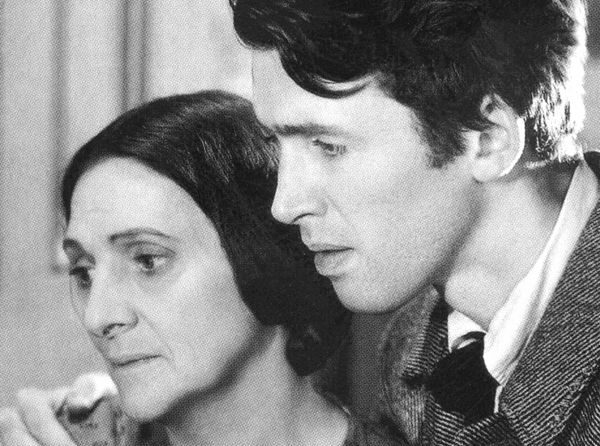
Stewart and Beulah Bondi in Of Human Hearts (1938)
13. Capra took inspiration from a famous financial figure in America
Capra looked to a famous figure at the time when creating George Bailey. Amadeo Giannini was a banker who started the Bank of Italy, which became the Bank of America. He was one of the first bankers to offer services to the working class and immigrants in America, and also financed classic films like Snow White and the Seven Dwarfs (1937), Gone with the Wind (1939) and West Side Story (1961). Capra was so impressed with Giannini’s humility that he partly based George Bailey on him.
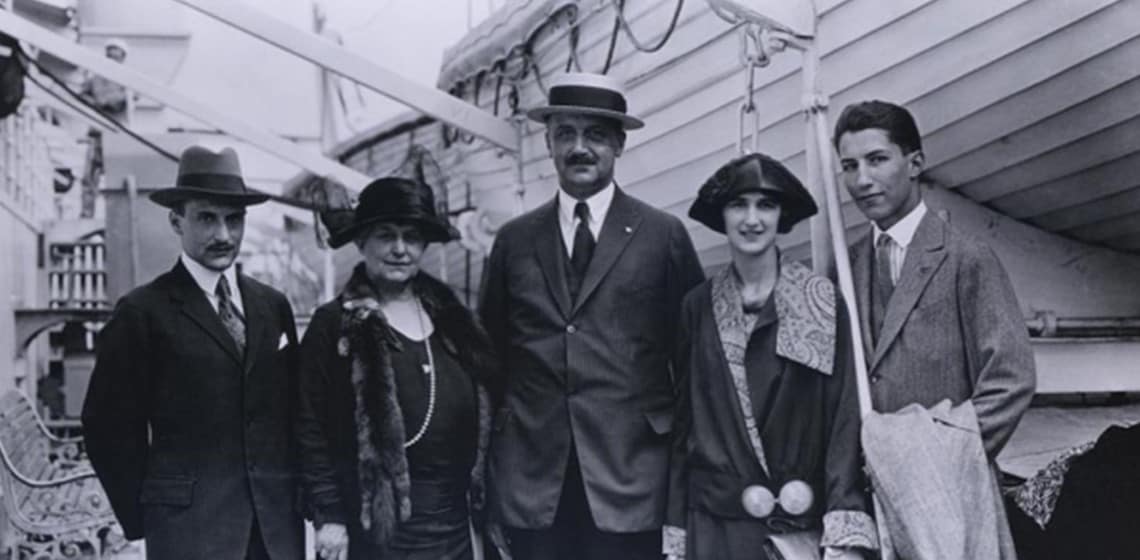
Amadeo Giannini, centre, with his family
14. Some big stars were considered to play Mary
Jean Arthur, who Capra had worked with in You Can’t Take It With You (1938) and Mr Smith Goes To Washington (1939), was his first choice, but she turned it down to do a Broadway play. Martha Scott, Ann Dvorak and Olivia De Havilland were also considered, and Ginger Rogers turned it down because, she said, Mary was too bland. In her autobiography years later, Rogers wrote about turning the part down, and expressd some regret, saying: “Foolish, you say?”
15. The famous kiss was filmed in real time.
The first time we see George and Mary kiss is one of the most famous moments in the film. It takes place when George and Mary are on the phone to George’s friend, Sam Wainwright. Sam is offering George a job, which George turns down, and instead starts kissing Mary. What’s unusual is that Capra filmed this whole scene in real time. So there was one unit, that Capra was part of, filming Jimmy Stewart and Donna Reed on-set. Then, on a different set, a second unit was filming Frank Albertson, who played Sam, at the same time. And Reed, Stewart, and Albertson are really on the phone to each other. When you watch this scene back, knowing this, it makes for interesting viewing.
The famous telephone kiss from It’s A Wonderful Life
16. Donna Reed won a very unusual bet whilst making the film
Donna Reed grew up on a farm in Iowa and, because of that, Lionel Barrymore, who plays Potter in the film, challenged her to a cow-milking contest on the set. She won, easily, and said it was the easiest $50 she ever made.
17. A key moment in the film was improvised by Jimmy Stewart
In the Wedding Day sequence, where George and Mary’s honeymoon is put on hold to stop a run on the bank, there’s a great moment of improvisation from Stewart. After Mary pulls out the $2,000 honeymoon savings, and George starts handing it out to his customers, Ms. Davis approaches the desk and asks for $17.50. It was in the script that she would ask for $17, but Capra asked Ellen Corby, who played Ms Davis, to ask for $17.50 instead. It took Stewart by surprise, and he improvised kissing her on the cheek in response.
Also, Ellen Corby, who plays Ms Davis, went on to play the Grandma in the Waltons and won three Emmys!
The bank run scene from the film
18. Thomas Mitchell did some ad-libbing too
There’s a scene where Uncle Billy leaves the Bailey home and, off-camera, it sounds like he stumbles into some trash cans. What actually happened was a crew member dropped a tray of props just after Thomas Mitchell, who played Billy, walked out of shot. And when we hear Billy off-screen shout, “I’m alright! I’m aaaaaalright!” that was improvised by Mitchell. Capra used this take in the final cut and gave the crew member who dropped the props a $10 bonus for improving the sound.
And Jimmy Stewart, who’s still on-screen looking off-camera, smiles when Mitchell improvises the line.
Great bit of ad-libbing from Thomas Mitchell
19. Lionel Barrymore had played an iconic Christmas character before
Henry Potter is the main antagonist of the film, and is played by Lionel Barrymore. He was a hugely experienced actor at that point, and fought off competition from Claude Rains and Vincent Price to win the part. He was famous for playing Ebenezer Scrooge on radio at that time so, with the obvious influence of A Christmas Carol on It’s A Wonderful Life, he was a shoo-in with Capra to win the role.
20. The first script written for the film was very different to what we see on the screen
The first writers who worked on the It’s A Wonderful Life screenplay were Clifford Odets, Marc Connelly, and Dalton Trumbo, who all wrote separate scripts. In Trumbo’s draft, George Bailey was a politician who grew more cynical as the story progressed, then tried to commit suicide after losing an election. Clarence then showed him Bedford Falls, not as it would be if he had never been born, but if he had gone into business instead of politics.
21. Capra hired new writers, but didn’t get on with them
After buying the rights from RKO and scrapping the Odets, Connelly, and Trumbo drafts of the script, Capra hired the husband and wife team of Albert Hackett and Frances Goodrich to help him write the screenplay. They did not get along at all. Frances Goodrich said, “Oh, that horrid man. He just couldn’t wait to get writing it all by himself.” When Hackett and Goodrich were writing the script, Capra was taking what they sent him and rewriting it behind their backs with a writer called Jo Swerling. He also brought in Dorothy Parker as a consultant. Albert Hackett said about Capra, “He’s a very arrogant sonofabitch. You don’t call Frances, ‘my dear woman,’ and get away with it.”
Then, when it came to assigning accreditation, because there were so many names involved in the final screenplay, the Screenwriters’ Arbitration Committee had to get involved. Hackett and Goodrich wanted Capra and Jo Swerling’s credits removed entirely. Capra agreed to Swerling being removed, but not himself. So that’s why the screenplay is credited to Frances Goodrich, Albert Hackett and Frank Capra. And Jo Swerling never spoke to Frank Capra again.
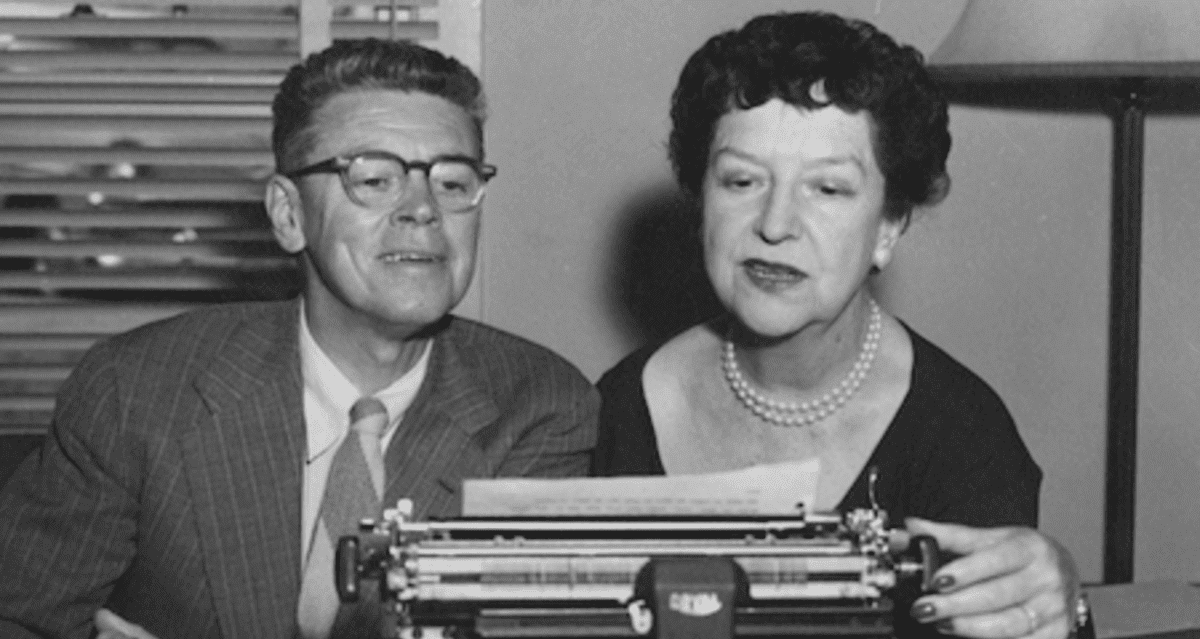
Albert Hackett and Frances Goodrich, co-writers of It’s A Wonderful Life, with Frank Capra
22. Capra and the writers took inspiration from some diverse sources
The movie derives influence from a variety of places, such as:
- Charles Dickens and A Christmas Carol is clearly an influence. George being shown what Bedford Falls would be like if he’d never been born is very similar to Ebeneezer Scrooge being visited by the three ghosts.
- Also, Potter is based on Scrooge. Greedy, heartless misers.
Capra also took a lot of inspiration from his own life. So:
- Harry becomes an engineer and George’s friend, Sam works in plastics. These both come from Capra’s own education in chemical engineering.
- The Martinis, who own the bar, are based on Capra’s own family, who emigrated from Sicily in 1903. In the movie, we see a goat in their car. “Capra,” means goat in Italian.
23. The movie changed a lot from the book
With there being so many writers, drafts, and versions of the script, by the time the writing process was complete, there were quite a lot of changes to the original book by Philip Van Doren Stern:
- In the book. George’s surname isn’t Bailey. It’s Pratt.
- The book starts with George on the bridge ready to kill himself. But, we never find out why he’s going to kill himself or see any of his life before the story starts.
- In the novel, there’s no mention of Clarence wanting wings, which is an iconic addition to the movie.
- And there’s no Mr. Potter at all in the book.
24. Capra fell out with the music composer on the movie
The composer on the film was Dmitri Tiomkin, a highly accomplished classical arranger who had been nominated for 2 Oscars, and already worked with Capra on several previous movies. This didn’t stop Capra replacing some of his music, though. Capra wasn’t keen on some of the musical cues Tiomkin wrote so replaced them with stock music from the RKO library. And, in the finale of the film, Tiomkin had used Ode To Joy – the famous classical piece by Frederick Schiller and Beethoven – and Capra replaced it with Hallelujah from the Hunchback of Notre Dame – an RKO film from 1939.
There were also several other scenes in the film – one of them being the drugstore sequence at the start – that Tiomkin composed music for, and Capra ditched the music entirely but didn’t bother to tell Tiomkin until he saw the film.
As a result, Tiomkin and Capra fell out and, years later, in his autobiography, ‘Please Don’t Hate Me’, Tiomkin called It’s A Wonderful Life, “a scissors job.”
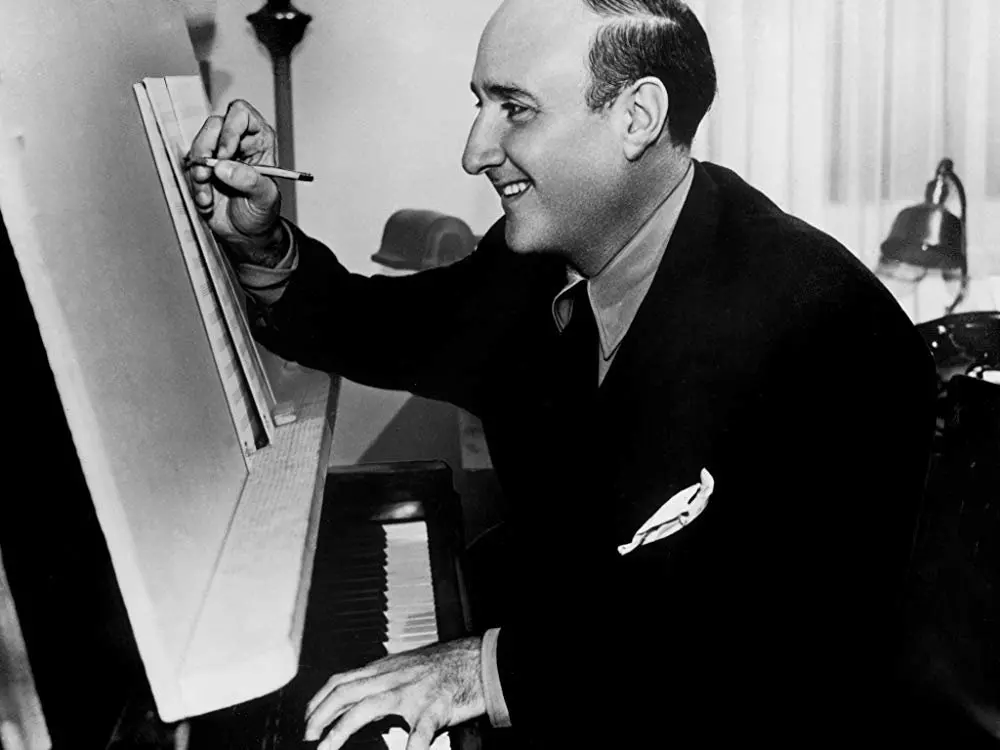
Dmitri Timokin, the composer on It’s A Wonderful Life
25. He also fell out with the DP!
There were actually 3 Directors of Photography that worked on It’s A Wonderful Life. First off, Capra hired a cinematographer called Victor Milner. He was hugely experienced but, after just a few weeks, Capra fired him. He wasn’t happy with how the film was looking and almost everything that Milner filmed was re-shot.
So Capra turned to his trusted collaborator and friend, Joseph Walker. They’d worked together 20 times by this point, on titles such as Mr Deeds Goes To Town, You Can’t Take It With You and Mr Smith Goes To Washington but, midway through the shoot, Capra and Walker had a disagreement on how to shoot one of the scenes where we see George walking through Bedford Falls.
They shot it, Capra didn’t like it, and asked Walker to light it a different way, and shoot it again. Walker said no, the two men began arguing on the set, and Capra turned to Walker’s assistant, Joseph Biroc, and said, “can you shoot it the way I want?” and Joseph Biroc said, “Yes, I can,” so Capra – despite decades working together – fired Joseph Walker on the spot, and Joseph Biroc took over for the rest of the shoot. Hence, two credited DPs.
26. The Bedford Falls set was a huge undertaking
The set constructed for Bedford Falls was very impressive. It took 2 months to build and, at the time, was one of the biggest movie sets ever built. It covered 4 acres, included 75 stores and buildings, a working bank, a main street, a factory district and a residential and slum area. The main Street was 300 yards long – the equivalent of three city blocks.
There was also 20 transplanted oak tree and, for the snow scenes, 3000 tons of shaved ice, 600 tons of plaster and 6000 gallons of chemicals. And pigeons, cats and dogs were allowed to roam the set to give it a lived-in feel. Unfortunately, the set was razed to the fround in 1954, but we still see it in all its glory in the movie.
The famous moment George runs through Bedford Falls shouting, “Merry Christmas”
27. Capra and his team invented an award-winning snow machine
Before It’s A Wonderful Life was made, snow on film was always done by gathering a lot of cornflakes, painting them white, and dropping them into the scene. Whenever a film did this, though, the cornflakes made such a noise, that dialogue had to be dubbed in later. Capra wanted to record the sound live so, instead, they came up with a new effect using soap, water, and foamite (the subatance you find in fire extinguishers). They then pumped 6000 gallons of this through a wind machine and it creates the affect of snow. And the RKO effects team won a special Oscar for their innovation.
28. George’s daughter was named after a U.S. sweet snack
The name of George’s daughter is Zuzu, and she’s played by Karolyn Grimes. Zuzu is named after a brand of biscuits that were popular in the US in the 40s, which is why George says, “Zuzu! My little ginger snap,” when he sees her.
George and Zuzu in the film
29. Capra broke a famous Hollywood code when he made the film
Back in 1946, movies were still operating under the Hays Code, a self-imposed industry set of guidelines for all motion pictures released between 1934 and 1968. The code prohibited profanity, suggestive nudity, graphic or realistic violence, sexual persuasions, and rape in movies. It also stated that antagonists in movies must either be punished, or repent for their actions, at the end of the film – Capra broke this rule. Potter steals George’s $8,000 but, as far as we know, he makes off with the cash and is never uncovered as the culprit.
30. The film was a huge flop on its release, until a copyright issue made it popular again
On a budget of $3.7m – a very expensive movie at the time – It’s A Wonderful Life made just $3.3m at the box office and left Capra’s Liberty Pictures half a million dollars in debt. The critics at the time weren’t bowled over by it either:
Bosley Crowther, writing for The New York Times, said: “The weakness of this picture is the sentimentality of it – its illusory concept of life. Mr. Capra’s nice people are charming, and his small town is a beguiling place but somehow, they don’t resemble reality.”
And Manny Farber wrote in the New Republic: “To make his points, Capra always takes an easy, simple-minded path that doesn’t give much credit to the intelligence of the audience”.
When Liberty Films went under, they were bought out by Paramount Pictures, and It’s A Wonderful Life sat gathering dust for years. Then, in 1974, due to an error, the movie copyright wasn’t renewed correctly, which led to the film passing into public domain. This meant it was free for TV stations to broadcast, and it started being show on television every Christmas. The status of the film grew and, by the mid-80s, it was a firm Christmas classic. Since then, and after all the copyright issues were sorted out, NBC have broadcast the film every Christmas Eve in the US, and Channel 4 do the same in the UK.
After the film’s big resurgence in popularity, Frank Capra said:
“It’s the damnedest thing I’ve ever seen. The film has a life of its own now and I look at it like I had nothing to do with it. I’m like a parent whose kid grows up to be president. I’m proud… but it’s the kid who did the work.”
Nowadays, of course, the critics have very different opinions on It’s A Wonderful Life.
Roger Ebert, says: “What is remarkable about It’s a Wonderful Life is how well it holds up over the years. Some movies, even good ones, should only be seen once. Other movies can be viewed an indefinite number of times. Like great music, they improve with familiarity. It’s a Wonderful Life falls in that category.”
And Empire magazine awarded the film 5 stars out of 5, and said: “A supremely entertaining homily on simple goodness.. The kind of experience movies were invented for… James Stewart’s journey to despair and back warms the cockles like nothing else.”
Bonus fact 1: There could have been an It’s A Wonderful Life sequel
In 2013, two producers called Allen J. Schwalb and Bob Farnsworth announced they would be continuing the story of It’s A Wonderful Life in a sequel called: It’s A Wonderful Life: The Rest Of The Story. The synopsis for this movie is on IMDb, and reads:
George Bailey’s troubled grandson (also named George Bailey) is forever changed when his Aunt Zuzu (played again by Karolyn Grimes) comes back as an angel and reveals how much better the world would have been had he never been born.
But, despite Allen J. Schwalb and Bob Farnsworth’s best efforts, Paramount – who owned the copyright to the film – released a statement, saying: “No project relating to It’s A Wonderful Life can proceed without a license from Paramount. To date, these individuals have not obtained any of the necessary rights, and we would take all appropriate steps to protect those rights.”
So, short of a Christmas miracle for Schwalb and Farnsworth, it appears there project won’t see the light of day.
Bonus fact 2: A town in New York claims to be the real Bedford Falls
Outside of filmmaking, the film has also had – and continues to have – quite a big impact on a little town in New York. A town called Seneca Falls claims to be the real-life inspiration for Bedford Falls, and each year they program a full lineup of Christmas-themed events: you can take a ride on the Bedford Falls Express, have a pister dinner at Mrs Martini’s Restaurant, visit the Bedford Falls Bells, or take part in the It’s A Wonderful Life participation movie.
However, there’s a film historian called Jeanine Basinger, who says: “I have been through every piece of paper in Frank Capra’s diaries, his archives, everything. There’s no evidence of any sort whatsoever to support this claim.”
But, whether you believe it or not, if you’re around New York during the holiday period, maybe swing by Seneca Falls for some Christmas cheer, It’s A Wonderful Life-style.
Visit their website at therealbedfordfalls.com for more information.
So, there you have it – the making of a true Christmas classic by way of 30 of the most festive-filled fun facts you could ever read. Please share on your social platforms, and listen to our podcast on It’s A Wonderful Life, here.


